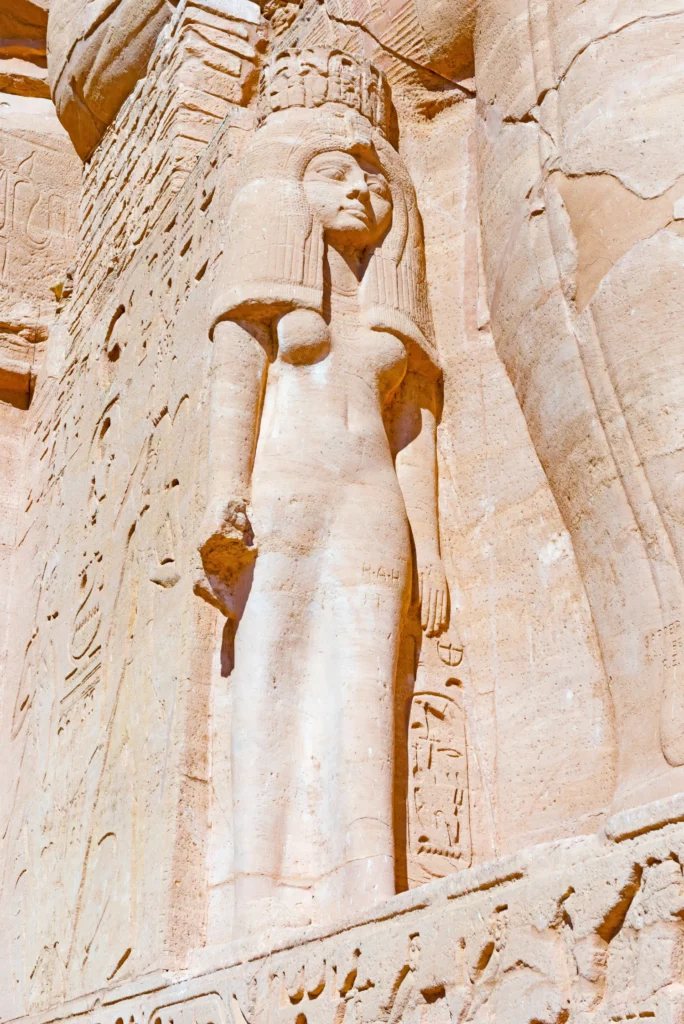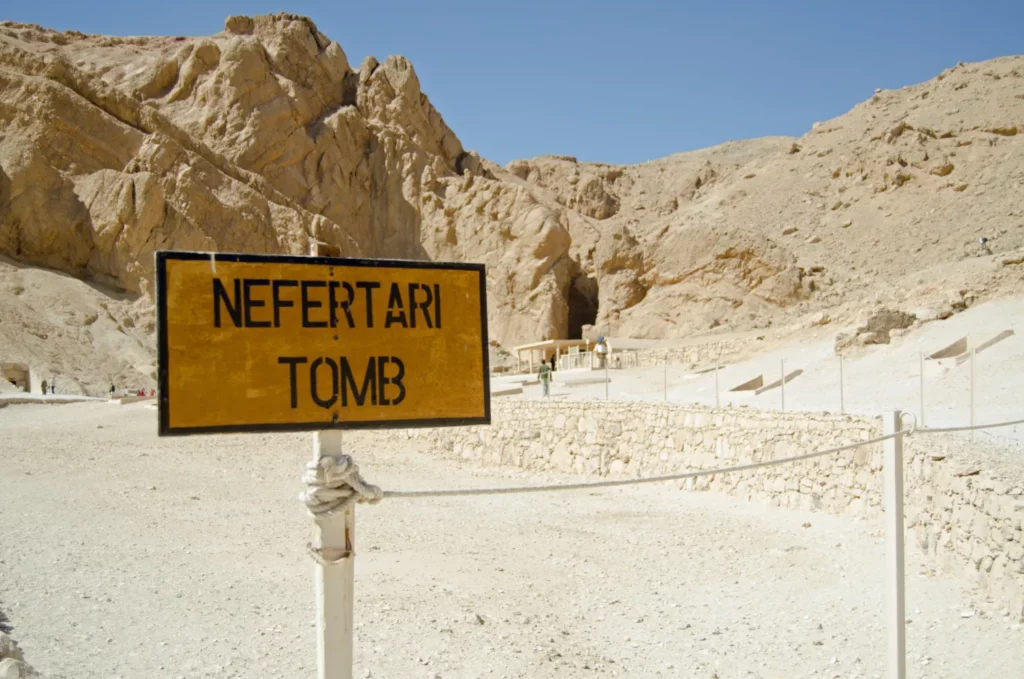Tomb of Nefertari: Egypt’s Most Vivid Archaeological Discovery

Updated On: February 19, 2024 by Noha Basiouny
Once it was discovered by British archaeologist Howard Carter in 1922, the tomb of King Tutankhamun instantly turned into a worldwide fascination. Such a discovery is by all means one of the most significant ons in Egyptian history, as the tomb was completely preserved. Ever since it was closed over 3,000 years ago, no one could ever locate it, let alone dare to annoy the young pharaoh.
Among the many things the world has been fussing about are the thousands of treasures that were found scattered everywhere in the tomb’s chambers, inside the pharaoh’s very sacred coffin and even between layers of linen that wrapped his mummy. Most of these fantastic artefacts are now displayed at the Egyptian Museum in Tahrir Square, to which thousands of tourists flock every year to gaze in awe at the beauty and innovation of ancient Egypt.
The great recognition the tomb of King Tut has received over more than a century, however, seems to have overshadowed other no less significant archaeological discoveries. One of such amazing ones, for instance, was the stunning discovery of the tomb of Queen Nefertari, another gold medalist in ancient Egyptian art, innovation and excellence.
In this article, we are going to take you on a journey to the tomb of Queen Nefertari, by far one of the largest and most beautifully vivid tombs ever built in ancient Egypt. So bring along a cup of coffee and read on.
Queen Nefertari
Before we get to the tomb of Nefertari and understand what makes it that remarkable, it makes sense to learn a thing or two about who Nefertari was in the first place. In fact, Queen Nefertari was one of the most famous queens of ancient Egypt, a name that was meant to be amongst other majestic women who changed the course of history for this country, such as the mighty Queen Hatshepsut.
Queen Nefertari was the first and royal wife of Pharaoh Rameses II or Ramesses the Great, who is considered the most powerful ancient Egyptian king of all time. His reign stretched for 67 years and he had a lifetime of 90 years, and both were filled with terrific achievements and huge changes which he made in Egypt.

In the ancient Egyptian language, Nefertari means the Beautiful One or the Most Beautiful of Them All, and she certainly was very pretty, as depicted on the walls of her magnificent tomb.
Besides her beautiful name, Nefertari also had so many different titles, including the Sweet of Love, Lady of Grace, Lady of All Lands and the One for Whom the Sun Shines. The latter was actually given to her by Ramesses II himself, which indicates how much love and affection he had for her.
The origin and childhood of Nefertari are pretty much unknown. The only record of anything like that was an inscription of her name combined with King Ay in a cartouche on a wall of her tomb. The thing is, King Ay was an 18th Dynasty pharaoh who ruled from 1323 to 1319 BC, way before Nefertari was born. If she were in any way related to him, she would be his granddaughter or even great-granddaughter. However, that was not confirmed anywhere.
What is known for sure is that Nefertari married Ramesses II when he was still a prince and while his father, King Seti I, who also had one of the most magnificent tombs, was still in power. Nefertari was either the same age as or a few years younger than Ramesses. Some say she was around 13, and he was 15 when they married, or maybe a little older than that.
Once Ramesses II became the pharaoh in 1279 BC—when he was around 24 at the time—and because Nefertari was his first wife—yes, he had many other wives—she became the royal queen. Ramesses II ruled during the 19th Dynasty of the New Kingdom. This was one of the three golden ages of ancient Egypt.
Together, the couple had four sons and two daughters; some records even say they were four daughters. Nefertari died in 1255 BC; she was probably in her early to mid-forties. Ramesses II, on the other hand, lived until he was 90 and died in 1213 BC.
Tomb of Queen Nefertari
Despite the little-known things about Nefertari’s life, it was evident that her relationship with Ramesses II was very special. She was his closest and most favourite wife, and he was deeply in love with her. This was extremely clear from what he did after her death to honour her life. He left her a legacy that would make her remembered for eternity, best represented by the vivid, lavish tomb he built for her.
This vivid, lavish tomb Ramesses II built for his wife is located in the Valley of the Queens, a UNESCO World Heritage Site. This is where the royal wives of ancient Egyptian kings were buried. The valley is situated on the west bank of the River Nile, opposite Thebes, modern-day Luxor.
The tomb was discovered in 1904 by Italian Egyptologist Ernesto Schiaparelli and was given the number QV66. Once he opened the door, Schiaparelli knew he was before a distinctive discovery no one had ever encountered before. The tomb was very beautiful. All the walls were decorated with amazingly vivid and colourful paintings. Not a single space was even left uncoloured.
Later on, the QV66 was nicknamed the Sistine Chapel of ancient Egypt because, in a way, it resembled the Sistine Chapel in the Apostolic Palace of the Vatican City.

Structure of the Tomb of Queen Nefertari
So what exactly is Nefertari’s tomb like?
Well, first of all, it is spacious. Very. In fact, This is one of the largest tombs in the entire Valley of the Queens, with a total area of 520 square metres.
To get to the tomb, one has to descend over 20 steps because, yes, it is underground, basically carved out of a limestone cliff. Then a huge metal door, which was installed there after the tomb’s discovery, opens to a whole new realm of beauty, elegance and vividness.
The tomb was made of three chambers. The first one is the antechamber, to which the second chamber is connected through a small corridor on the right. Both chambers are on the same level. Then the third one, the burial chamber, the largest of the three, is on a lower level and attached to the antechamber by another set of steps.
The burial chamber is quite wide and alone has an area of 90 square metres. It has four columns that support the ceiling. On its right and left sides, there are also two annex rooms.
The burial chamber is the sanctum of the tomb and its most sacred place. This is supposedly where the coffin of the Queen was placed. This is also where, according to ancient Egyptian religion, the deceased was brought back to life for judgement.
Decorations in the Tomb of Queen Nefertari
The tomb of Nefertari is one true representation of the love and affection Ramesses II had for his wife. Besides its huge size, what is even more magnificent about this tomb is the stunning paintings and decorations that stayed colourful and vivid even after thousands of years. They are literally beyond any description.
First of all, the ceiling is painted dark blue with thousands of golden five-angle stars that depict a clear summer night sky. All the walls of the tomb have white backgrounds painted on top of them, so many scenes and portraits of the Queen.
The antechamber, for instance, is decorated with scenes and paintings taken from the Book of the Dead. This is an ancient Egyptian book containing about 200 spells believed to have guided the deceased in the afterlife.
On the walls of the antechamber, we can find different paintings of the ancient Egyptian gods, including Osiris, the god of the dead and afterlife and Anubis, the guide to the underworld and one who protected graves, as well as Nefertari herself welcomed by them. They are all painted in different bright colours on that white background.
Besides the paintings, there are countless texts in hieroglyphics again taken from the Book of the Dead and written everywhere besides the paintings, as if they explain what the painted scenes are about.
The paintings do not only foresee how Nefertari would be doing in her afterlife, but they also depict what her earthly life was like. One painting, for instance, shows the Queen playing senet, which was an ancient Egyptian board game.
One wall of the burial chamber is divided into two parts. The upper one shows the mummy of Nefertari surrounded by two falcons on the right and left sides, a lion, a heron, and a male figure, all dazzling in beautiful bright colours. The lower part features large texts in hieroglyphics, again taken from the Book of the Dead, written vertically on a white background.
The columns of the burial chamber are also decorated with different paintings of the Queen. On the walls of this chamber, as well, there are so many different scenes of Nefertari with different gods and divine creatures, including, but limited to, Horus, Isis, Amun, Ra and Serket.
The Queen’s name was found in several cartouches on the walls of her tomb. These are oval-shaped paintings where the name of the royal was written. As we mentioned earlier, one of them combines Nefertari with King Ay with no other reference to why they both were written in the same cartouche or what their relationship could be.
The artists who did all this amazing work took special care of showing how beautiful Nefertari was. There are so many portraits of her shown wearing a beautiful white dress, a vulture headdress and a plum-shaped crown. In all of them, the Queen has outlined eyes and eyebrows, blushy cheeks and a beautiful physique.
Besides everything we mentioned so far, there is still one last thing that shows how much Ramesses II cared about honouring his wife. That is, there is not even a single portrait of him with Nefertari, in a way that would falsely indicate she was single. It is like Ramesses II totally stepped aside and made her tomb all about her.
Robbery of the Tomb of Queen Nefertari
It does not take a genius to know that a tomb as big and spectacular as Nefertari’s would be filled to the top with countless treasures of all kinds, colours, shapes, materials, and values. At the time of the Queen’s burial, the tomb must have been stuffed with artefacts, figures, jewellery, clothes and any belongings those who buried her thought she would need in the afterlife. This was something ancient Egyptians were famous for, anyways.
But when Ernesto Schiaparelli opened the tomb over a century ago, it was clear that he was not the first to do that.
Unlike the tomb of King Tut, which remained untouched ever since it was closed after the pharaoh’s burial thousands of years ago until its discovery in 1922, the tomb of Nefertari was pretty much, well, empty. Everything that was once buried with the Queen was stolen. Even Nefertar’s coffin and mummy were stolen.
The only thing that remained in this tomb, and, thankfully, was preserved, was the vivid paintings on the walls, apparently because they were parts of the tomb, which itself was part of a cliff. Otherwise, thieves would not have missed them.
It is not known when or how the tomb was located and robbed, but this could have happened during a time of chaos. As scholars agreed, the 18th, 19th and 20th Dynasties together made the New Kingdom of Egypt. This was the last of the three golden ages of ancient Egypt.
The New Kingdom was then followed by the Second Intermediate Period. As the name suggests, this was a period of conflicts and mayhem where the pharaohs, as well as the military, were weakened. So laws were violated, crimes were increasingly committed, and tomb robberies, like the Baby Shark song, went viral. This could be when the tomb of Nefertari was robbed.
The only few items that were found in the tomb at the time of its discovery in 1904 were a piece of golden bracelets, an earring, a few small Ushabti figures of the Queen, a pair of sandals and fragments of her granite coffin. Some of those are currently found in the Egyptian Museum in Cairo.
In addition to these items, two mummified legs were found in the tomb. Using modern research methods, it was proven that they belonged to the Queen herself. Unfortunately, they are not in Egypt because Ernesto Schiaparelli took them back to Italy for display at the Museo Egizio of Turin or the Egyptian Museum in Turin. They have been there since then.
Closure of Tomb of Queen Nefertari
The fantastic tomb of Nefertari was, and still is, an outstanding archaeological find that had to be shared with the entire world. Not only those interested in ancient Egypt or even art advocates but almost everyone on this planet needed to see these beautiful and surprisingly well-preserved paintings that are beyond comparison.
So ever since it was discovered, Nefertari’s tomb was opened to tourists. Over the years, the paintings were so exposed to bacteria, salt formation, humidity and even water that they started to deteriorate. This made the Egyptian authorities close the tomb in 1950 for fear of losing the paintings altogether.
Luckily, in 1986, a project to restore the deteriorated paintings of Nefertari’s tomb was agreed upon between the Egyptian Antiquities Organisation and the American Getty Conservation Institute. The project started in 1988 and was completed four years later, and the tomb, once again, returned to its original wonderful well-conserved state.
Since then, the Getty Conservation Institute has been closely monitoring the tomb to make sure it stays in a good state.
To protect the tomb, preserve its alluring paintings and not waste four years of hard work, Egypt decided to reopen the tomb to visitors but only gave access to a maximum of 150 of them at a time.
However, that did not seem to work either. So it had to be boiled down even more. In 2006, the tomb was closed once again to the public. Only private tours of a maximum of 20 people were granted access under the condition of obtaining a special licence for $3,000—we know, too expensive.
To help attract more tourists and revive tourism which was affected by the political situation in the country since 2011, Egypt lifted the restrictions on the tomb’s entry and allowed whoever wants to pay tribute to the Queen to visit her very sacred tomb for a ticket of EGP1400—still expensive, we know (shrug gesture!)
Winter is the best season to visit Luxor (and Aswan) and spend a wonderful vacation exploring some of the world’s most fascinating monuments. If you ever make it there, make sure you visit the beautiful tomb of Queen Nefertari. Although admission is a little bit costly, once you descend these steps and enter the sacred realm of ancient Egypt, you will instantly know that this experience is totally worth it.
Once you are done with that, do not forget to stop by King Tut’s tomb, which is only 8.4 kilometres from that of Queen Nefertari. This is another attraction you must never miss visiting while in Luxor.







It would be nice to know if her husband had the part of the Exodus with the Hebrew Israelites or a timeline of her and history of events during her life. It would be good to know things about her personality, personal ideas and accomplishments in her lifetime. Would she have been related to Moses adopted mother? Etc…? Thank you.
The Queen’s mummified legs needs to be returned to Egypt. Rameses is supposedly my ancestor via the Arundel/Howard family.
As world renowned professor and Egyptian historian Bob Brier told his students once..the museums probably want to give things back but can’t .it would open the flood gates on all museums to return everything.. great article 👍
The Queen got Justice for her dad despite the step mother’s interference and radical, manipulative homicidal behavior ♥️
I totally agree. Everything that has been taken from Egypt should be returned. On my last visit, I felt privileged to see Pharo Ramesses the second in the Cairo museum and Pharo Tutankhamen in his tomb on the west bank. To me it was like finding the holy grail. My soul has always been pulled back to ancient Egypt, Pharo Ramessis and Karnak. It hurts my soul that so much of Egypt’s ancient heritage heritage is scattered around the world and not home where it truly belings
My comment is simply a measure of the deep anger, disgust, etc. I feel concerning the out-right theft, greed, & audacity of FOREIGNERS to steal, lay claim, & ownership of a society’s wealth & art which existed well before the North American continent. It is shameful to say the least.
The way these “archeologists” sell off the personal items of the diseased to museums and personal collectors is disgusting. And then you let random people wander around these sacred spaces that were intended to be private. Let these people rest in peace the way that they were found and intended to be. Stop looting their tombs and transporting there items across the globe. You took her legs for crying out loud. Shame on all of these people. You are disrespecting these sacred places for greed and it is heartbreaking, disgusting and immoral. Return the items to there proper place and leave them alone.
Will you ever find nefertari how could such gold and artifacts be sold knowingly of whear it came from .
I agree she lived and passed in Egypt not Italy. Therefore they should be returned.
There never was an exodus and the jews didn’t build the pyramids and were never slaves there… don’t believe Charlton Heston
Nina, I totally agree! This is where she belongs.